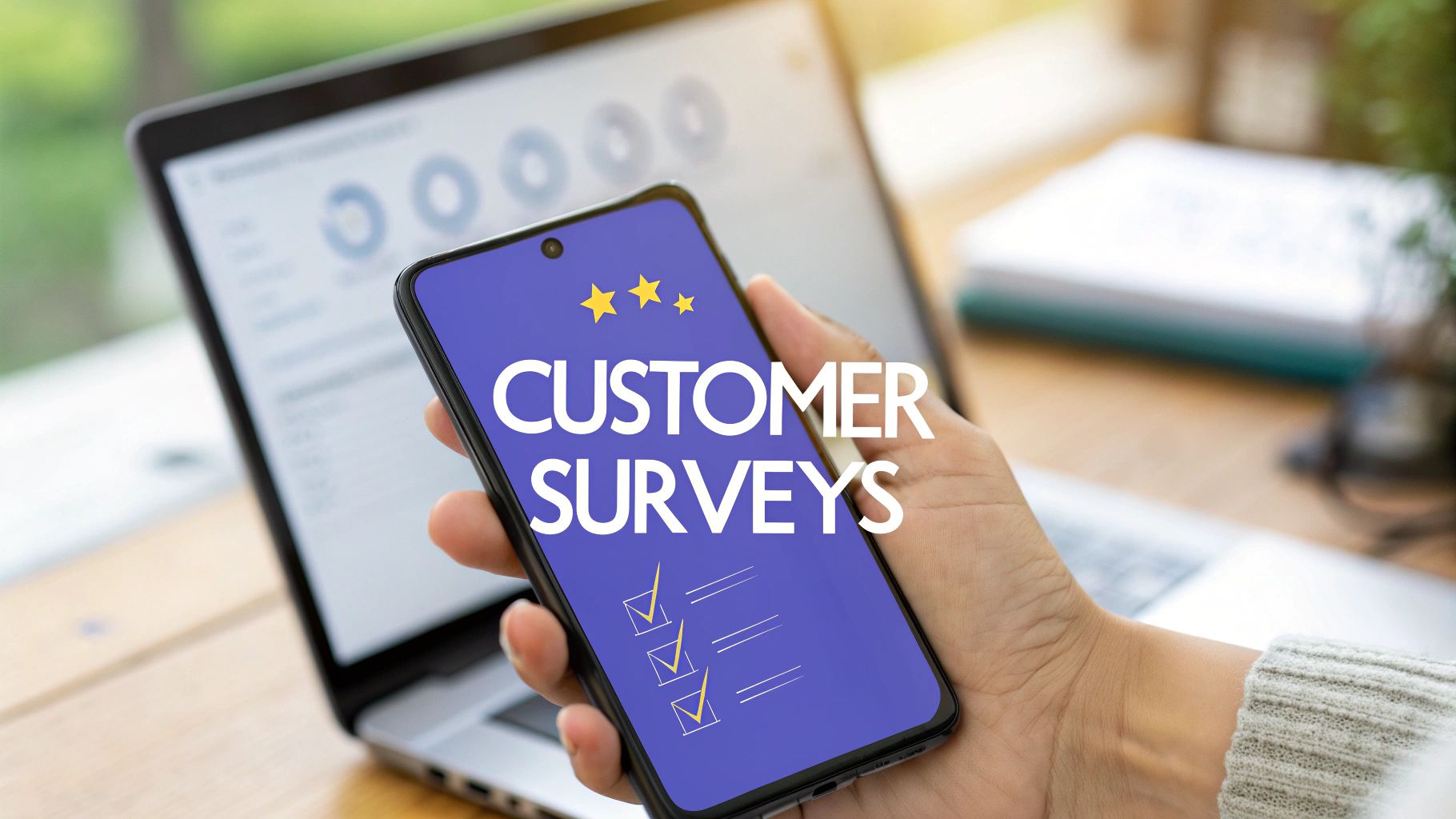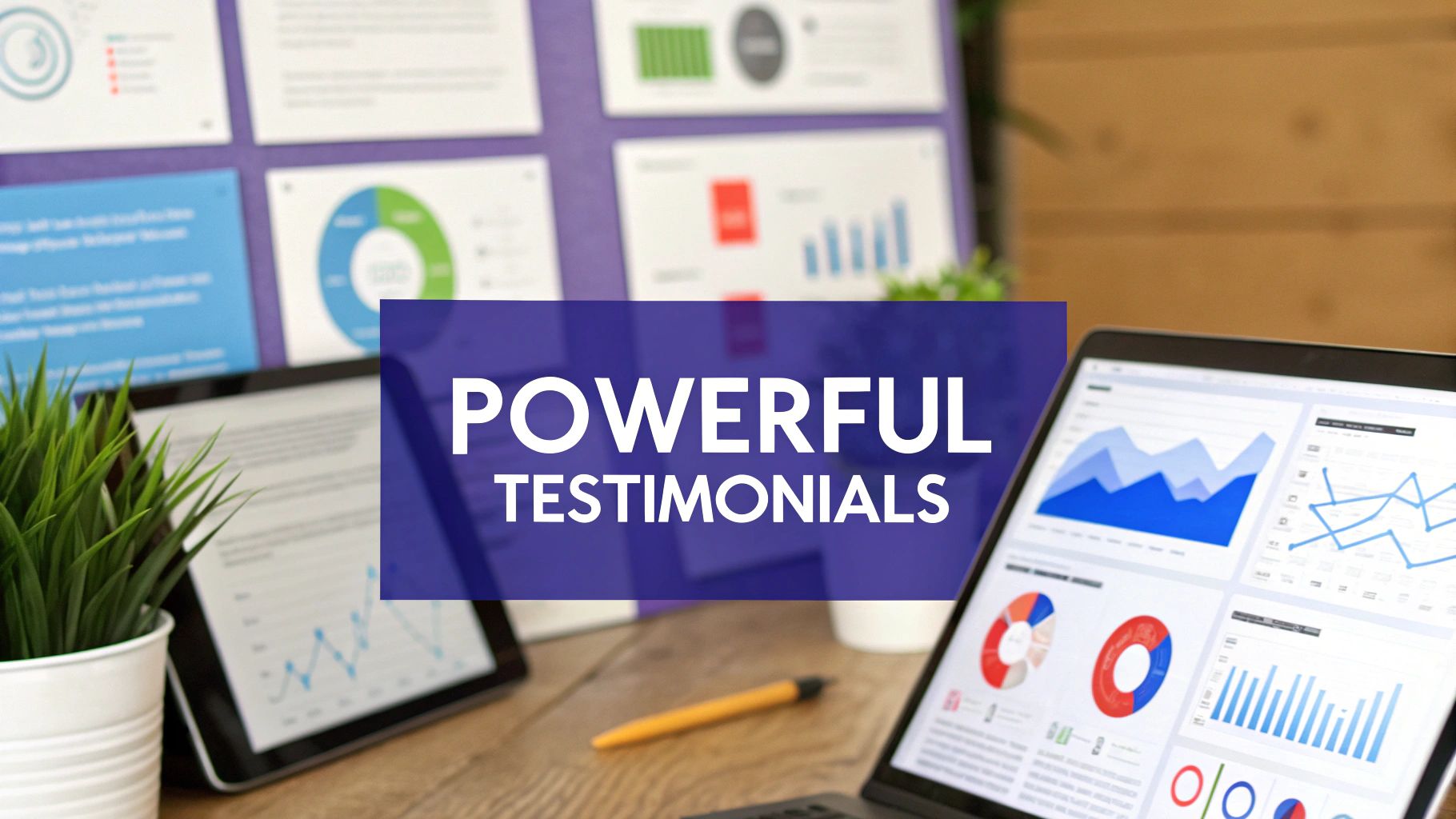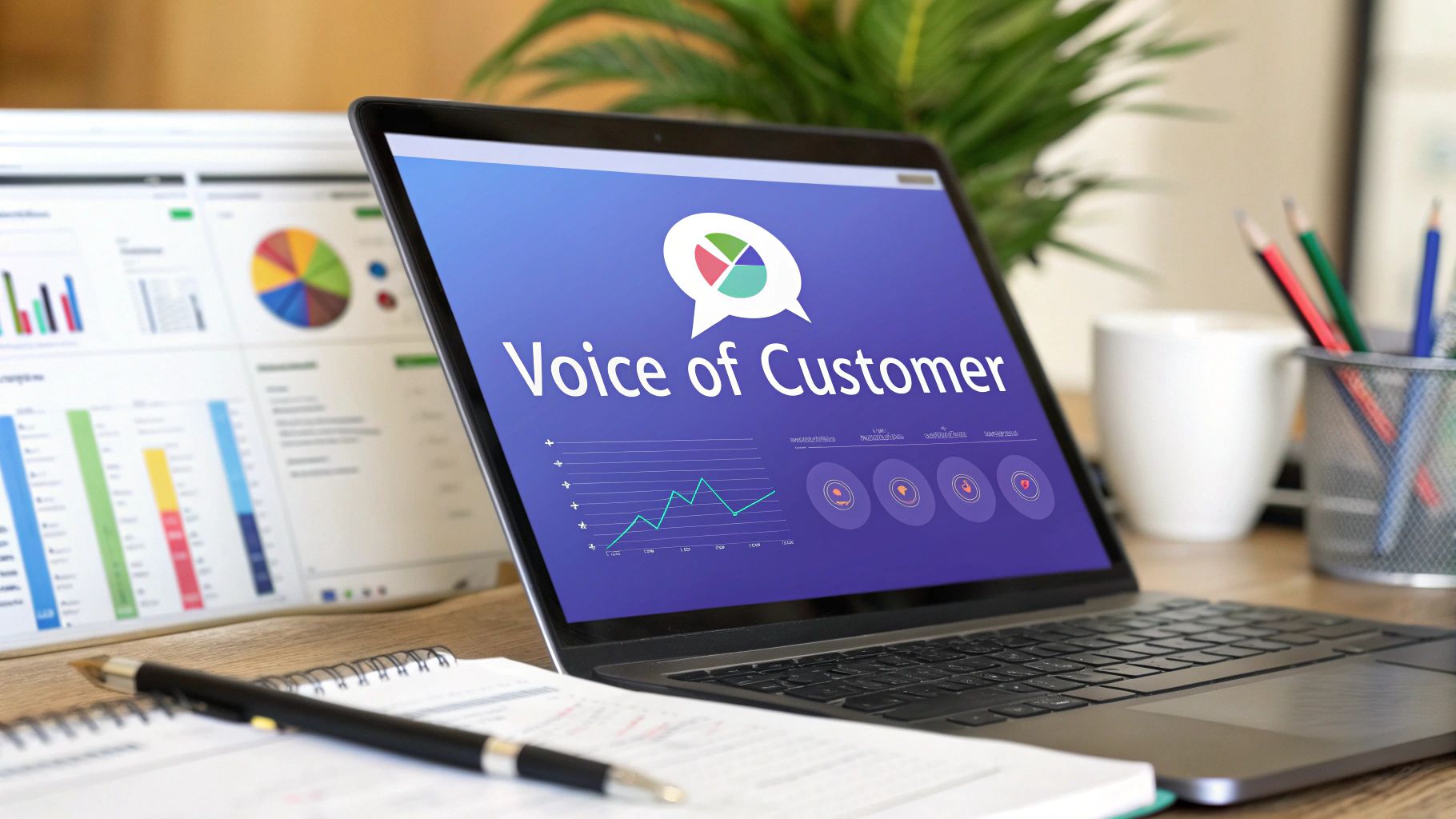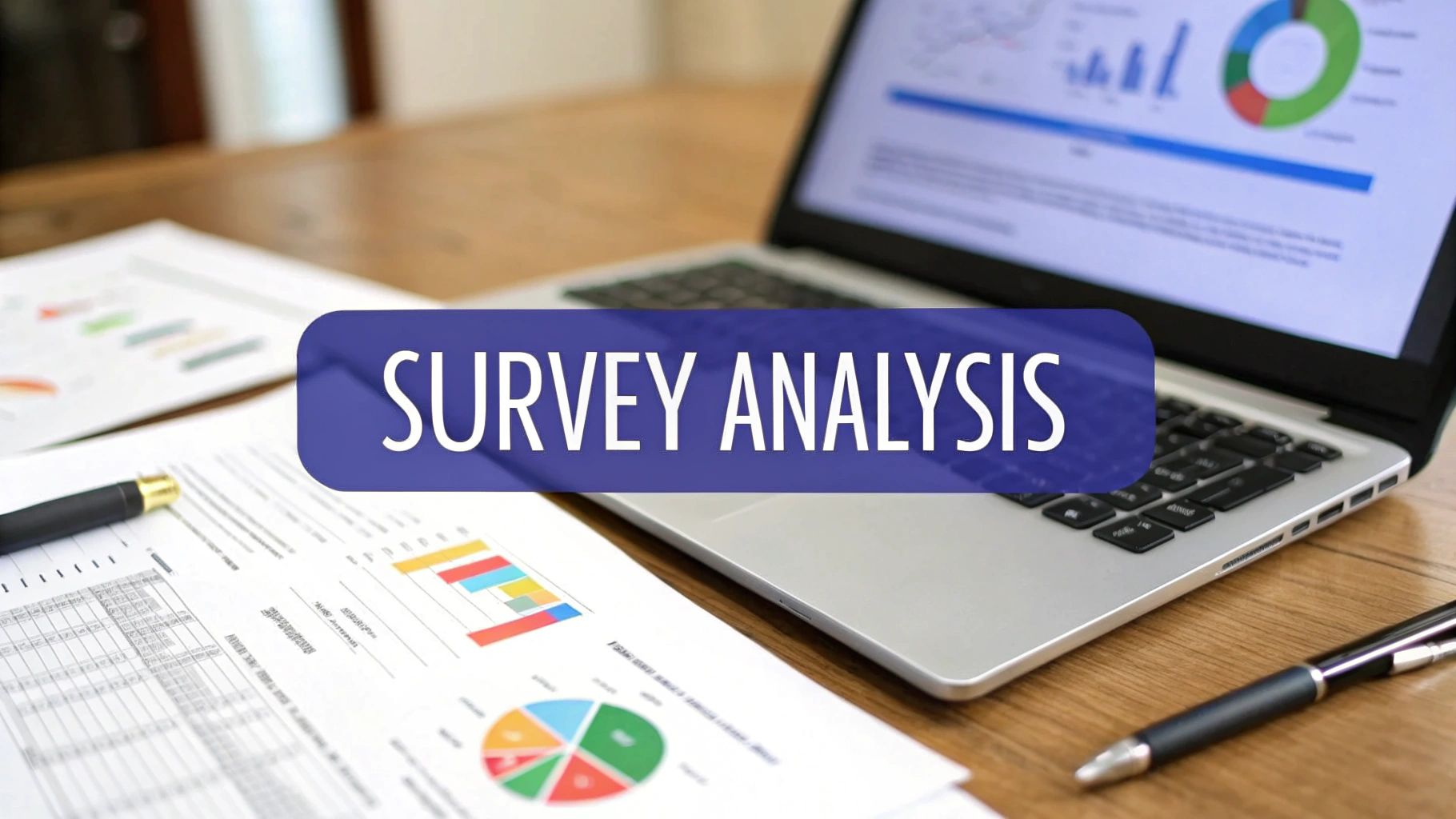Effective Surveys for Customer Feedback to Boost Loyalty
Discover top strategies for surveys for customer feedback that improve satisfaction and drive stronger business growth.

Think of customer feedback surveys as your direct line to the people who matter most: your users. They are the tools that cut through the noise, giving you structured, honest feedback about what people really think of your product, service, and overall experience. When used right, this data helps you make smarter decisions, stop customers from leaving, and figure out which product updates to tackle next.
Why Customer Feedback Surveys Are Your Growth Compass

Imagine trying to steer a ship through unfamiliar waters without a map or a compass. That's pretty much what you’re doing when you run a SaaS business without a steady stream of customer feedback. You might have a destination in mind, but you’re basically just guessing which way to turn.
Customer feedback surveys are your navigational tools. They give you the insights you need to chart a clear course forward, turning guesswork into a confident strategy.
This is not just about putting out fires. A consistent flow of feedback becomes the guiding force for your entire company, helping you anticipate market shifts, fine-tune your roadmap, and build a culture that’s genuinely obsessed with the customer.
Proactive Problem Solving and Churn Reduction
One of the best things about collecting feedback is catching friction points before they snowball into major problems. When you start seeing a pattern of complaints about a specific feature, you have a chance to jump in and fix it proactively.
This is a game-changer for SaaS companies trying to reduce churn. We all know the stats: acquiring a new customer can cost five times more than keeping an existing one. By actually listening to what your users are telling you, you can solve their frustrations and give them a solid reason to stick around.
A business absolutely devoted to service will have only one worry about profits. They will be embarrassingly large.
When you let feedback guide you, your focus shifts from reactive damage control to proactive, continuous improvement. That's where the real magic happens.
Building a Customer-Centric Roadmap
So, how do you decide what to build next? Too often, product decisions are based on gut feelings, assumptions, or whoever has the loudest voice in the meeting. Customer feedback surveys completely change that dynamic by plugging real user needs directly into your planning process.
You can use feedback to:
- Validate new ideas by asking users if a feature you’re considering would actually solve a problem for them.
- Prioritize your backlog by figuring out which improvements will deliver the biggest bang for the buck for the most users.
- Discover new opportunities when customers suggest use cases or ideas you never even thought of.
When you systematically collect and analyze survey data, your roadmap stops being a list of features and starts becoming a reflection of what your customers actually want. This alignment is the bedrock of sustainable growth and the secret to building a product people genuinely love to use.
Choosing the Right Type of Customer Survey
Picking the right survey is a bit like choosing the right tool for a job. You wouldn't use a sledgehammer to hang a picture frame, right? In the same way, you don't want to use a long-term loyalty survey to measure how a customer feels about a single support ticket.
Different surveys for customer feedback are built to answer very specific questions. Nail this choice, and you'll get sharp, actionable insights. Get it wrong, and you'll end up with fuzzy, generalized opinions that don't help you improve. Each survey type is a unique lens, giving you a different perspective on the customer experience.
Net Promoter Score (NPS): The Loyalty Metric
Think of the Net Promoter Score, or NPS, as your business's relationship barometer. It measures the big picture of long-term brand health and customer loyalty.
The beauty of the NPS survey lies in its simple but powerful core question: "How likely are you to recommend our company/product to a friend or colleague?" Customers respond on a scale from 0 to 10, and their answers sort them into three distinct groups:
- Promoters (9-10): These are your champions. They are enthusiastic advocates who will go out of their way to spread good words about you.
- Passives (7-8): These folks are content, but not committed. They’re satisfied for now, but they could easily be swayed by a competitor's shiny new offer.
- Detractors (0-6): These are your unhappy campers. They're at risk of churning and might share their negative experiences and actively damage your brand's reputation.
To get your final NPS score, you just subtract the percentage of Detractors from the percentage of Promoters. A SaaS company, for example, might send an NPS survey every quarter to keep a finger on the pulse of customer loyalty and spot any worrying trends before they blow up.

This image nails a key point: no matter which survey you choose, asking clear questions is the absolute foundation for getting useful feedback.
Customer Satisfaction (CSAT): The Transactional Snapshot
While NPS gives you the wide-angle view, the Customer Satisfaction score, or CSAT, is your zoom lens. It hones in on a specific moment in time to measure a customer's happiness with a particular interaction. It's all about getting immediate feedback on one distinct part of their journey.
CSAT surveys typically ask something like, "How satisfied were you with your recent experience?" The answer is usually on a simple 1-to-5 scale, from "Very Unsatisfied" to "Very Satisfied." The key is to send it right after the event, while the memory is still fresh.
For a SaaS business, this might mean triggering a CSAT survey the second a user closes a support chat or right after they finish the onboarding sequence. This gives you a real-time pulse on how well your individual touchpoints are performing.
The real power of CSAT is that it ties feedback directly to a specific team or process, making it incredibly easy to pinpoint and fix any friction points.
Customer Effort Score (CES): The Ease-of-Use Indicator
Last but not least, we have the Customer Effort Score, or CES. This survey measures one simple thing: how easy was it for your customer to get something done? The idea behind it is powerful because customers stick with companies that make their lives easier. Removing friction is one of the most direct paths to building loyalty.
A typical CES question might be, "How much effort did you personally have to put forth to handle your request?" or "The company made it easy for me to handle my issue," with answers on a scale from "Strongly Disagree" to "Strongly Agree."
A high effort score is a massive red flag. It’s telling you that your processes are clunky and causing frustration. For instance, if a user has to jump through five different screens just to update their billing info, a CES survey will light that pain point up like a Christmas tree.
While your satisfaction rates might look okay on the surface, loyalty can be a different story. Recent global research shows that key indicators like trust and repurchase intent are actually on the decline, which suggests that standard surveys can miss deeper issues. You can read the full research on these loyalty trends from the Qualtrics XM Institute. By focusing on making things easier for your customers, you directly improve their experience and build the kind of loyalty that lasts.
Choosing the Right Customer Feedback Survey
With these three core metrics in mind, how do you know which one to use and when? It all comes down to what you're trying to learn. This table breaks down the key differences to help you decide.
Ultimately, these surveys are not mutually exclusive. The most successful SaaS companies use a combination of NPS, CSAT, and CES to get a complete, 360-degree view of their customer experience, from the big-picture relationship down to the nitty-gritty of individual interactions.
Designing Surveys People Actually Want to Complete

Knowing what to ask is only half the battle. The real challenge is designing a survey that people actually finish. A poorly designed survey gives you bad data and actively frustrates your customers, potentially souring their opinion of your brand.
The goal is to make the experience as frictionless as possible. Think of it less like an interrogation and more like a brief, helpful conversation. When you respect your customer's time and intelligence, you dramatically increase the chances of getting the thoughtful responses you need.
Keep It Short and Focused
The single biggest reason people ditch a survey is its length. In a world of shrinking attention spans, a long, winding questionnaire is a recipe for a low completion rate. One study found that once a survey takes longer than 7-8 minutes to complete, abandonment rates can soar by up to 20%.
Before you add another question, stop and ask yourself: "Is this absolutely necessary to achieve my goal?" Every single question needs to have a clear purpose. If it's just a "nice to have," cut it.
A tightly focused survey with five relevant questions is far more valuable than a sprawling twenty-question monster that gets ignored. Your customers are busy. Showing them you respect their time is the first step toward earning their feedback.
A great survey should feel effortless. If a customer has to stop and think about what a question is really asking, you’ve already introduced friction that could cause them to drop off. Clarity and brevity are your best friends.
Use Clear and Unbiased Language
The way you word your questions has a massive impact on the answers you get back. Vague or confusing language leads to inaccurate data, while biased questions will only confirm your own assumptions instead of revealing the truth.
A leading question, for example, subtly pushes the user toward a specific answer. Instead of asking, "How much did you enjoy our amazing new feature?" you should ask something neutral, like, "What are your thoughts on our new feature?" The second option invites honest feedback, not just validation.
Similarly, avoid double-barreled questions that ask about two different things at once. A question like, "Was our support team fast and helpful?" is a classic example. A user might feel the team was fast but not helpful, or vice versa, leaving them unable to answer accurately. Split it into two separate questions to get clean, actionable data.
For a deeper look into crafting effective questions, you can explore these survey design best practices.
Mix Up Your Question Types
To get the full picture, you need a blend of quantitative (the "what") and qualitative (the "why") data. Mixing different question formats keeps the survey engaging and allows you to gather both types of insights.
Here’s a practical mix you can use:
- Rating Scales: Use questions with a numerical scale (like 1-5 or 1-10) for metrics like CSAT or CES. This gives you hard data that's easy to track and benchmark over time.
- Multiple Choice: These are great for quickly segmenting your audience or learning preferences without making users type out a long response.
- Open-Ended Questions: This is where you find the gold. A single, well-placed open-ended question like, "What is one thing we could do to improve your experience?" can provide more insight than ten multiple-choice questions combined.
The key is balance. Too many open-ended questions can feel like homework, but too few will leave you guessing about the reasons behind the scores. A good rule of thumb is to follow up a rating scale question with an optional open-ended one to capture context. This combination gives you the structure of numbers and the richness of stories for a complete view of the customer experience.
Putting Your SaaS Feedback Strategy into Action
Once you've picked out the right surveys and figured out how to design them, the real work begins: building a repeatable system. For a SaaS company, this means weaving feedback collection right into the fabric of your user experience, not just sending a one-off questionnaire.
This means getting strategic about your goals, tools, and timing to create a continuous conversation with your customers. A well-executed feedback strategy does more than just gather data; it can completely shift your company's focus from internal guesswork to what your users actually need.
Define Your Goals First
Before you even think about sending a survey, you have to know what you're trying to accomplish. Without a clear goal, your efforts will be all over the place, and the data you collect won't tell you much of anything.
Are you trying to figure out why new users bail during onboarding? Or are you hunting for ideas for your next big feature?
Setting a specific goal is the foundation of everything. For instance, a SaaS company bleeding subscribers might set a goal to "find the top three reasons for churn among users with subscriptions older than six months." That single, clear objective dictates which survey you choose, the questions you ask, and who you send it to.
Choose the Right Tools for the Job
Your tech stack plays a huge part in how well you can pull this off. The tools you pick should make it easy to send surveys, make sense of the results, and actually do something with them. The market for surveys for customer feedback has plenty of options:
- Simple Form Builders: Tools like Google Forms or Typeform are great for getting your feet wet. They're straightforward and perfect for one-time surveys or collecting basic info without a big investment.
- Integrated Feedback Platforms: For a SaaS business, specialized platforms pack a lot more punch. Tools like Surva.ai are built to trigger surveys based on what a user does inside your app, automatically segment responses, and connect with your other systems. This creates a far more dynamic and automated feedback loop.
The right tool should fit what you need today but also have room to grow with you. A platform that can fire off a survey right after a user takes a specific action will give you much richer, more contextual feedback than a generic email blast ever could.
A successful feedback program is about asking the right user the right question at precisely the right moment in their journey. The right technology makes this possible at scale.
Master the Timing and Distribution
How and when you ask for feedback is just as important as what you're asking. The sweet spot is always when the experience is still fresh in the customer's mind. This contextual approach boosts response rates and dramatically improves the quality of the feedback you get.
Think about these key moments in a typical SaaS user journey:
- After Onboarding: Send a quick survey to see how new users felt about getting set up. This is your best chance to spot early friction points that could lead to churn down the road.
- Following a Support Interaction: Trigger a quick CSAT survey the moment a support ticket is closed. This gives you a direct pulse on how your customer success team is performing.
- After Using a New Feature: The first time a user tries out that new feature you just launched? Ask them what they think. You'll get immediate validation and ideas for improvement.
- Upon Cancellation: It's tough to see a customer go, but a well-timed exit survey can provide priceless insights into why they left. This is gold for preventing future churn.
By tying your surveys to specific events, you show users you care about their experience in the moments that actually matter.
Close the Feedback Loop
This last step is the most important, and it's also the one most companies forget: closing the feedback loop. This is all about showing your customers you heard them and, more importantly, that you did something about it. It’s the difference between a one-way data grab and a genuine, two-way relationship.
Closing the loop can be as simple as sending a personal email to a user who reported a bug to let them know it’s been fixed. Or it can be a broader announcement in your newsletter, like, "You asked, we listened! Based on your feedback, we've just launched..."
This simple act of acknowledgment proves their opinions are valued. It encourages them to keep giving you feedback and builds the kind of loyalty that turns regular customers into your biggest fans.
Turning Raw Survey Data into Actionable Insights
Collecting responses from your surveys for customer feedback is a great start, but the raw data itself is just a pile of numbers and comments. The real magic happens when you turn that information into clear, actionable intelligence your team can use to make smarter decisions.
This process involves looking at the data from two different angles: the quantitative and the qualitative. One tells you what is happening, while the other explains why.
Starting with Quantitative Analysis
Quantitative data gives you the hard numbers, the metrics you can track over time. Analyzing scores like NPS and CSAT is about more than just finding an average; it’s about spotting trends and patterns that tell a story.
For example, a sudden drop in your CSAT score for support interactions is a huge red flag that something is wrong. Tracking these metrics consistently lets you set benchmarks and see if your improvement efforts are actually moving the needle.
A powerful technique here is data segmentation. Instead of looking at all your users as one big group, you can slice the data to compare different segments. A SaaS company, for instance, could compare the satisfaction scores of new users who just finished onboarding against those of power users who have been with them for years. This might reveal that your onboarding process is a major point of friction or that your long-term customers are running into new problems.
Collecting feedback is like mining for gold. You have to sift through a lot of material to find the valuable nuggets, but those nuggets can guide your entire product strategy.
Diving into Qualitative Analysis
While numbers tell you what’s happening, qualitative feedback from open-ended questions gives you the story behind the scores. This is where you uncover the specific pain points, frustrations, and brilliant suggestions that numbers alone can’t capture.
The key is to look for recurring themes. As you read through text responses, start categorizing them. You might create tags for things like "confusing UI," "missing feature," or "slow performance."
Soon, patterns will emerge. If 15% of your detractors mention the same confusing step in your checkout process, you’ve just found a high-impact area for improvement. For a deeper look at different analysis methods, check out our complete guide on how to approach survey data analysis.
Using Modern Tools to Speed Up the Process
Manually reading and tagging hundreds of open-ended responses is a massive time sink. This is where modern tools, particularly those with sentiment analysis, come in handy. These systems can automatically scan text responses and classify them as positive, negative, or neutral. This gives you a quick, high-level overview of customer sentiment without reading every single word.
Ultimately, transforming data into action is a continuous cycle. For a deeper look into making the most of your data, explore how to utilize customer feedback for continuous improvement. By blending quantitative tracking with qualitative insights, you create a complete picture of the customer experience, empowering your team to make informed, user-focused decisions.
Looking Beyond Surveys to Other Feedback Channels
Relying only on surveys for customer feedback is like watching a movie with the sound off. You get the main plot points, but you miss out on all the nuance, context, and emotion. To really understand what your customers are thinking and feeling, you have to listen everywhere they're talking, not just when you ask them a direct question.
Think of yourself as a detective on a case. A single clue is a start, but you only crack the case by gathering evidence from multiple sources. This is where unsolicited feedback comes in. It’s the raw, unfiltered commentary your customers share on their own terms, and it's incredibly valuable.
Tapping into Unsolicited Feedback
Unsolicited feedback lives in the organic, day-to-day conversations happening all around you. These channels are packed with the kind of context that a structured survey can never quite capture, giving you a much more complete and honest picture of customer sentiment.
You'll find this goldmine of organic feedback in places like:
- Social Media Comments: Platforms like X (formerly Twitter), LinkedIn, and Reddit are public squares where users celebrate what they love and air their grievances for all to see.
- App Store Reviews: If your SaaS has a mobile app, these reviews are a direct line to user feedback on bugs, feature requests, and overall user experience.
- Support Tickets and Live Chats: Your support team's inbox is a pipeline straight to your users' biggest headaches and most pressing questions.
- Sales Call Notes: The notes your sales team takes can reveal exactly why a prospect chose you over a competitor, or what made them hesitate.
While surveys give you direct answers, the public chatter that shapes your brand's image is just as important. This makes effective online reputation management services a vital piece of your overall feedback strategy.
Listening to Your Internal Teams
Don't forget about the feedback channel right under your own roof: your customer-facing teams. Your support and sales folks are on the front lines every single day, hearing directly from users about what’s working and what’s falling flat. They have a ground-level perspective you just can't get anywhere else.
Creating a simple internal process for these teams to log recurring issues or feature requests can surface important insights. They often spot trends long before they ever show up in survey data.
Global studies back up this shift toward a multi-channel approach. One massive survey of over 23,000 consumers found that while online surveys are still popular, channels like social media and chat are rapidly gaining ground, especially in digitally-savvy markets. You can see more on these global feedback channel trends from the XM Institute.
For a deeper look into building a more complete listening strategy, check out our guide on how to get customer feedback from a wide range of sources.
Ultimately, a strong feedback program is about combining surveys with other channels. You need to blend the structured, quantitative data from surveys with the rich, qualitative insights from organic conversations. That comprehensive approach is how you move from just collecting data to truly understanding and delighting your customers.
Even with the best strategy in place, you’re bound to run into a few questions when you start putting your customer feedback plan into action. Let’s tackle some of the most common ones that pop up, so you can move forward with confidence.
How Often Should I Send Surveys?
This is a classic "it depends" situation, but the answer really hinges on your goal. If you're sending transactional surveys, like a CSAT after a support ticket is resolved, you should send it immediately. The experience is fresh in their mind, and that’s the perfect time to ask about it.
On the other hand, relationship surveys like NPS are a different beast. These are designed to track long-term loyalty, so sending them out quarterly or semi-annually is usually the sweet spot. Fire them off too often, and you’ll run headfirst into survey fatigue, which is when customers just start ignoring you. Find a rhythm that feels helpful, not annoying.
What Is a Good Survey Response Rate?
Everyone asks this, but there’s no single magic number to aim for. Response rates can swing wildly depending on your industry, who you're asking, and how you send the survey.
Just to give you a ballpark:
- Internal surveys sent to employees often see rates of 30-40% or even higher.
- External surveys for customers typically land in the 10-15% range.
Instead of chasing a universal benchmark, focus on getting a sample that actually represents your customer base. A small, representative sample is way more valuable than a large, skewed one. Just track your own response rate over time and look for trends. Small tweaks to your survey design or a simple incentive can make a huge difference.
How Can I Get More Honest and Detailed Feedback?
Getting truly candid feedback boils down to two things: trust and good design.
If you want honesty, guarantee anonymity whenever you can. This is especially true if you’re asking about sensitive topics. People are far more likely to open up when they know their name isn't attached to their comments.
To get more detail, ditch generic, lazy questions like "Any comments?" That’s an invitation for a one-word answer. Instead, ask something specific that gets them thinking, like, "What is one thing we could do to make this feature better for you?"
Most importantly, show them you’re actually listening. When you follow up or announce product updates based on their suggestions, you close the feedback loop. This proves their voice matters, and it gives them a powerful reason to share their thoughts again next time.
Ready to turn customer feedback into your biggest growth driver? Surva.ai gives SaaS teams the tools to collect actionable insights, reduce churn, and build a product users love. Start getting to know your customers on a deeper level. Learn more and get started with Surva.ai.


